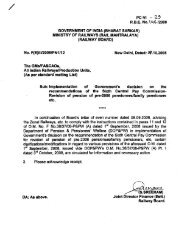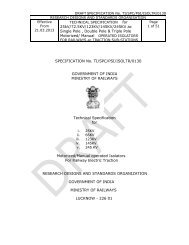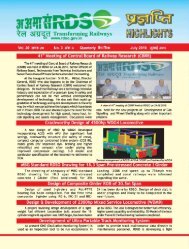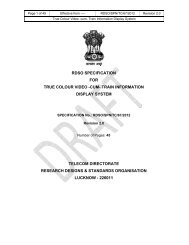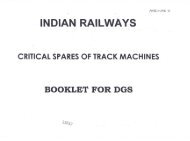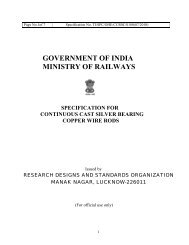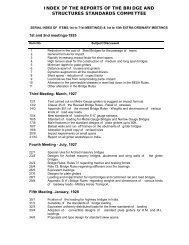ASSESSMENT OF RESIDUAL LIFE OF GIRDERS OF BRIDGE No
ASSESSMENT OF RESIDUAL LIFE OF GIRDERS OF BRIDGE No
ASSESSMENT OF RESIDUAL LIFE OF GIRDERS OF BRIDGE No
Create successful ePaper yourself
Turn your PDF publications into a flip-book with our unique Google optimized e-Paper software.
d) The fatigue life of standard spans has been assessed by calculating the<br />
design life factor k1. This factor has been worked out as σRmax/(σ0 x k3)<br />
and fatigue life calculations have been done by inversion, using the<br />
equations given in Clause 9.2.3 of BS-5400 Pt.-10 by taking fatigue life as<br />
minimum of the following:<br />
Fatigue Life<br />
or<br />
<br />
120<br />
…………………………………………………………..(2)<br />
m<br />
k1<br />
Fatigue Life <br />
120<br />
…………………………………………………………(3)<br />
2<br />
k<br />
m<br />
1<br />
Where m = 3.0 taken from Table-8 for detailed Class ‘D’.<br />
e) Value of RU loading factor k3 has been taken from Table-4 of the code<br />
considering the case of heavy traffic loading, corresponding to the base<br />
length (L) of the influence line diagram for the girder.<br />
f) Value of GMT factor, k4 is assumed as 1.0 for GMT of 18 to 27 million<br />
tonnes. Actual GMT data suggests that this assumption is very much on<br />
conservative side.<br />
g) For single lane loading value of lane factor, k5 is taken as 1.0.<br />
4.2 Method-2: Fatigue life assessment with damage calculations :<br />
4.2.1 General : This method involves a calculation of Miner’s summation<br />
and may be used for any detail for which S-N relationship is known for any<br />
known load or stress spectrum. This method may be used as a more precise<br />
alternative to the simplified procedure as described in para. 4.1of this report.<br />
The essential information which is required to assess the fatigue life of a<br />
structure is the pattern of stresses likely to be observed in it, during the<br />
passage of normal traffic and the relationship between the applied stress<br />
cycles and the number of times these can be withstood by the material of the<br />
structure. This can be achieved by subjecting the representative samples<br />
not only to varying constant amplitude cycles or stresses but also to<br />
complete stress spectrum. Using test results and curve fitting technique, S-N<br />
relationship can be obtained. Under normal service conditions, Railway<br />
bridge structures are subjected to spectrum of varying stress – amplitude<br />
and therefore, a process of damage accumulation continues. The fatigue<br />
damage depends on the combined effect of the frequencies of different<br />
stress ranges, likely to be observed by the structure under service loading.<br />
Referring to Palm-gren Miner’s theory of linear damage accumulation , the total<br />
damage to the structure is given by D= ∑ ni/Ni.<br />
Where , ni = Observed number of stress cycles for different stress<br />
ranges<br />
7



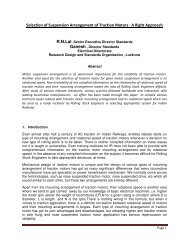

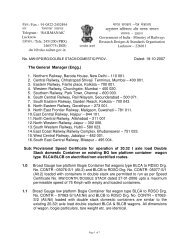
![Hkkjrljdkj] jsy ea= ky; vuql a/ kkuvfHkdYivkSj ekudlax Bu y ... - rdso](https://img.yumpu.com/21978459/1/184x260/hkkjrljdkj-jsy-ea-ky-vuql-a-kkuvfhkdyivksj-ekudlax-bu-y-rdso.jpg?quality=85)

